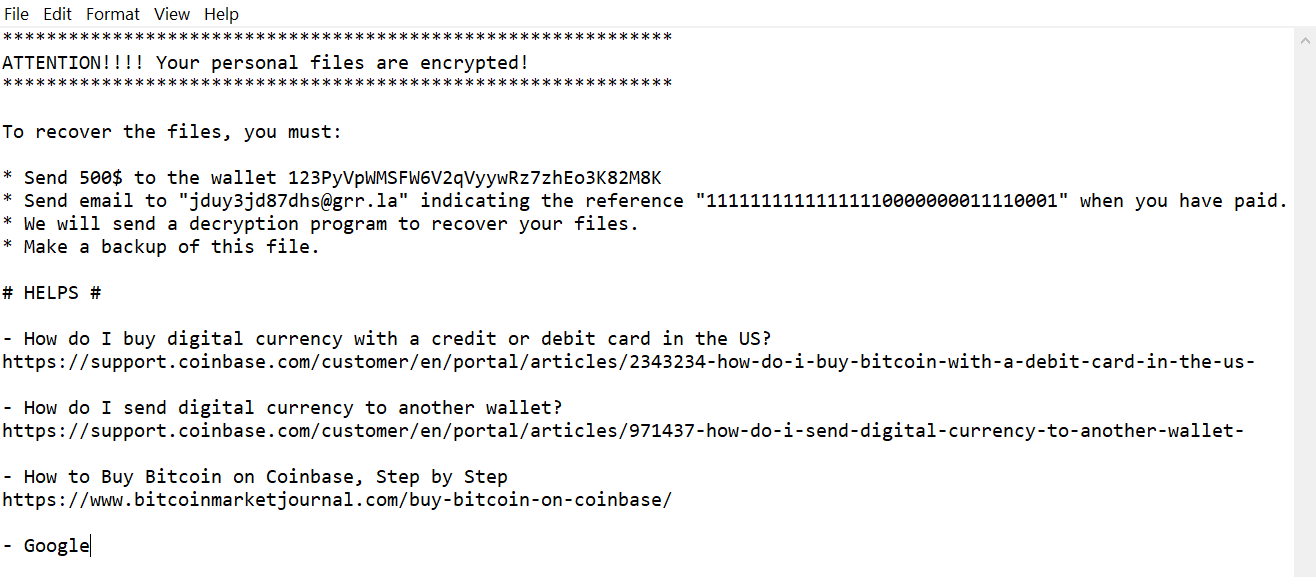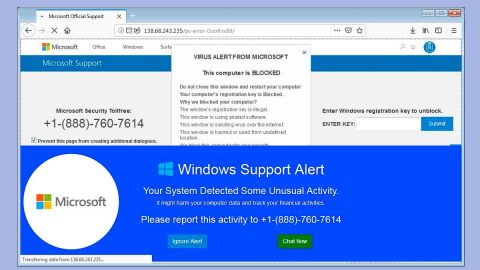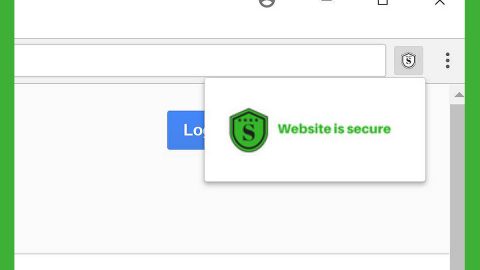What is 010001 ransomware? And how does it carry out its attack?
010001 ransomware is a crypto-virus that was identified at the beginning of November 2018. This crypto-malware is written in Python and seems to be a new variant of Noblis ransomware according to security experts. Its first victims were found in Japan but it does not necessarily mean that this crypto-malware only targets users from Japan as it could infect users from other parts of the globe as well.

The instant its malicious payload is dropped on a targeted machine, 010001 ransomware will start to carry out its attack. It connects the computer to a remote Command and Control server where it downloads other files that will be used for its attack. These files are placed in system folders. It then begins employing an information-gathering module to obtain data in the system. The obtained information will be used for the other module called stealth protection which is used to keep the crypto-malware undetected. 010001 ransomware also makes modifications in the Windows Registry to achieve persistence in its attack. After that, it scans the computer in search for files with the following extensions:
.3dm, .3g2, .3gp, .7zip, .aaf, .accdb, .aep, .aepx, .aet, .ai, .aif, .as, .as3, .asf, .asp, .asx, .avi, .bmp, .c, .class, .cpp, .cs, .csv, .dat, .db, .dbf, .doc, .docb, .docm, .docx, .dot, .dotm, .dotx, .dwg, .dxf, .efx, .eps, .fla, .flv, .gif, .h, .idml, .iff, .indb, .indd, .indl, .indt, .inx, .jar, .java, .jpeg, .jpg, .js, .m3u, .m3u8, .m4u, .max, .mdb, .mid, .mkv, .mov, .mp3, .mp4, .mpa, .mpeg, .mpg, .msg, .pdb, .pdf, .php, .plb, .pmd, .png, .pot, .potm, .potx, .ppam, .ppj, .pps, .ppsm, .ppsx, .ppt, .pptm, .pptx, .prel, .prproj, .ps, .psd, .py, .ra, .rar, .raw, .rb, .rtf, .sdf, .sdf, .ses, .sldm, .sldx, .sql, .svg, .swf, .tif, .txt, .vcf, .vob, .wav, .wma, .wmv, .wpd, .wps, .xla, .xlam, .xll, .xlm, .xls, .xlsb, .xlsm, .xlsx, .xlt, .xltm, .xltx, .xlw, .xml, .xqx, .xqx, .zip
Once it finds its targeted files, it encrypts them using the AES cipher and appends the .010001 extension to each one of the encrypted files. Following data encryption, it opens a ransom note named “tmpsfn_as.txt” containing the following message:
“*************************************************************
ATTENTION!!!! Your personal files are encrypted!
*************************************************************
To recover the files, you must:
* Send 500$ to the wallet 123PyVpWMSFW6V2qVyywRz7zhEo3K82M8K
* Send email to “[email protected]” indicating the reference “11111111111111110000000011110001” when you have paid.
* We will send a decryption program to recover your files.
* Make a backup of this file.
# HELPS #
– How do I buy digital currency with a credit or debit card in the US?
https://support.coinbase.com/customer/en/portal/articles/2343234-how-do-i-buy-bitcoin-with-a-debit-card-in-the-us-
– How do I send digital currency to another wallet?
https://support.coinbase.com/customer/en/portal/articles/971437-how-do-i-send-digital-currency-to-another-wallet-
– How to Buy Bitcoin on Coinbase, Step by Step
https://www.bitcoinmarketjournal.com/buy-bitcoin-on-coinbase/
– Google”
How is the malicious payload of 010001 ransomware disseminated over the web?
The malicious payload of 01001 ransomware may be disseminated using several methods. For one, it may spread via spam emails in the form of an attachment. Aside from that, it may also spread using unprotected RDP configurations, deceptive downloads, exploit kits, and many more.
Eliminate 010001 ransomware with the help of the removal instructions given below.
Step_1: Close the program window of 010001 ransomware and if you can’t close it, tap Ctrl + Shift + Esc keys to launch the Task Manager.
Step_2: Go to Processes and look for the malicious processes of 010001 ransomware then right-click on it and select End Process or End Task.
Step_3: Close the Task Manager and open Control Panel by pressing the Windows key + R, then type in “appwiz.cpl” and then click OK or press Enter.
Step_4: Look for dubious programs that might be related to 010001 ransomware and then Uninstall it/them.
Step_5: Close Control Panel and then tap Win + E to launch File Explorer.
Step_6: After opening File Explorer, navigate to the following directories below and look for 010001 ransomware’s malicious components like tmpsfn_as.txt and [random].exe and other suspicious-looking files and then erase them all.
- %TEMP%
- %APPDATA%
- %DESKTOP%
- %USERPROFILE%\Downloads
- C:\ProgramData\local\
Step_7: Close the File Explorer.
Before you proceed to the next steps below, make sure that you are tech-savvy enough to the point where you know exactly how to use and navigate your computer’s Registry. Keep in mind that any changes you make will highly impact your computer. To save you trouble and time, you can just use Restoro, this system tool is proven to be safe and excellent enough that hackers won’t be able to hack into it. But if you can manage Windows Registry well, then by all means go on to the next steps.
Step_8: Tap Win + R to open Run and then type in Regedit in the field and tap enter to pull up Windows Registry.
Step_9: Navigate to the listed paths below and look for the registry keys and sub-keys created by 010001 ransomware.
- HKEY_CURRENT_USER\Control Panel\Desktop\
- HKEY_USERS\.DEFAULT\Control Panel\Desktop\
- HKEY_LOCAL_MACHINE\Software\Microsoft\Windows\CurrentVersion\Run
- HKEY_CURRENT_USER\Software\Microsoft\Windows\CurrentVersion\Run
- HKEY_LOCAL_MACHINE\Software\Microsoft\Windows\CurrentVersion\RunOnce
- HKEY_CURRENT_USER\Software\Microsoft\Windows\CurrentVersion\RunOnce
Step_10: Delete the registry keys and sub-keys created by 010001 ransomware.
Step_11: Close the Registry Editor.
Step_12: Empty your Recycle Bin.
Try to recover your encrypted files using their Shadow Volume copies
Restoring your encrypted files using Windows Previous Versions feature will only be effective if 010001 ransomware hasn’t deleted the shadow copies of your files. But still, this is one of the best and free methods there is, so it’s definitely worth a shot.
To restore the encrypted file, right-click on it and select Properties, a new window will pop up, then proceed to Previous Versions. It will load the file’s previous version before it was modified. After it loads, select any of the previous versions displayed on the list like the one in the illustration below. And then click the Restore button.
Congratulations, you have just removed 010001 Ransomware in Windows 10 all by yourself. If you would like to read more helpful articles and tips about various software and hardware visit fixmypcfree.com daily.
Now that’s how you remove 010001 Ransomware in Windows 10 on a computer. On the other hand, if your computer is going through some system-related issues that have to get fixed, there is a one-click solution known as Restoro you could check out to resolve them.
This program is a useful tool that could repair corrupted registries and optimize your PC’s overall performance. Aside from that, it also cleans out your computer for any junk or corrupted files that help you eliminate any unwanted files from your system. This is basically a solution that’s within your grasp with just a click. It’s easy to use as it is user-friendly. For a complete set of instructions in downloading and using it, refer to the steps below
Perform a full system scan using Restoro. To do so, follow the instructions below.













